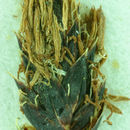Comments
provided by eFloras
Eleocharis bolanderi is clearly distinct from E. montevidensis, from which it differs in its dense, tufted habit with short, caudexlike rhizomes, its leaf sheaths without a tooth, its achene and tubercle shapes, and its acute floral scales.
Specimens of Eleocharis bolanderi without rhizomes or achenes are easily confused with E. decumbens, which often may be distinguished by culms 0.5–2 mm wide, and spikelets with scales sometimes more than 3 mm long. The tubercles of E. bolanderi are usually poorly developed and much lower than wide; in E. decumbens they are usually well developed and about as high as wide.
- license
- cc-by-nc-sa-3.0
- copyright
- Missouri Botanical Garden, 4344 Shaw Boulevard, St. Louis, MO, 63110 USA
Description
provided by eFloras
Plants perennial, densely tufted; rhizomes caudexlike, mostly hidden by culms and roots, short, 1.5–3 mm thick, hard, cortex persistent, internodes very short, scales not evident. Culms subterete, often with to 6 prominent ridges when dry, sulcate, 10–30 cm × 0.3–0.5 mm, firm to rigid, spongy. Leaves: distal leaf sheaths persistent, not splitting, proximally brown, red, or stramineous, distally stramineous, green or reddish, papery, apex sometimes reddish, obtuse, rarely callose, tooth absent. Spikelets ovoid, 3–8 × 2–3 mm, apex acute to obtuse; proximal scale amplexicaulous, entire; subproximal scale with flower; floral scales spreading in fruit, 8–30, 4–5 per mm of rachilla, dark brown to blackish, midrib regions often stramineous or greenish, ovate to lanceolate, 2–3 × 1.5 mm, apex entire, acute, often carinate in distal part of spikelet. Flowers: perianth bristles 3–6, whitish to stramineous, stout to slender, often unequal, from rudimentary to 1/2 of achene length; stamens 3; anthers dark yellow to brown, 0.9–1.4 mm; styles 3-fid. Achenes falling with scales, stramineous, rarely dark brown, ovoid to obpyriform, slightly to greatly compressed-trigonous, rarely thickly lenticular, angles prominent or abaxial angle obscure, 0.9–1.2 × 0.65–0.8 mm, apex narrowly to broadly truncate, neck short, often compressed more than body, at 20–30X finely rugulose with more than 20 horizontal ridges in a vertical series or reticulate or cancellate. Tubercles whitish to brown, pyramidal, lower than wide, often 3-lobed as viewed from the top, 0.1–0.3 × 0.4–0.65 mm.
- license
- cc-by-nc-sa-3.0
- copyright
- Missouri Botanical Garden, 4344 Shaw Boulevard, St. Louis, MO, 63110 USA
Distribution
provided by eFloras
Calif., Colo., Idaho, Nev., Oreg., Utah.
- license
- cc-by-nc-sa-3.0
- copyright
- Missouri Botanical Garden, 4344 Shaw Boulevard, St. Louis, MO, 63110 USA
Flowering/Fruiting
provided by eFloras
Fruiting late spring–summer.
- license
- cc-by-nc-sa-3.0
- copyright
- Missouri Botanical Garden, 4344 Shaw Boulevard, St. Louis, MO, 63110 USA
Habitat
provided by eFloras
Fresh, often summer-dry meadows, springs, seeps, stream margins; 1000–3400m.
- license
- cc-by-nc-sa-3.0
- copyright
- Missouri Botanical Garden, 4344 Shaw Boulevard, St. Louis, MO, 63110 USA
Synonym
provided by eFloras
Eleocharis montevidensis Kunth var. bolanderi (A. Gray) V. E. Grant
- license
- cc-by-nc-sa-3.0
- copyright
- Missouri Botanical Garden, 4344 Shaw Boulevard, St. Louis, MO, 63110 USA
Comprehensive Description
provided by North American Flora
Eleocharis bolanderi A. Gray, Proc. Am. Acad 7 : 392. 1868.
Culms very numerous, 1-3 dm. high, about 0.5 mm. in diameter, glaucous-green, erect and wiry, from a black, ascending, thick, woody rootstock ; sheaths usually stramineous, sometimes purplish at the base, 2-3 cm. high, slightly swollen at the indurated, purplish summit, rarely with a mucro ; spikelets 3-8 mm. long, elliptic to ovate, blunt or acute, about 10-20-flowered; scales dark brown to black, ovate, acute, with a short, whitened, scarious tip, the lowest orbicular; stamens 3; style trifid; achene obovoid, 1.5 mm. long, goldenyellow to black, trigonous with a blunt outer angle, with a cellular surface under magnification, the truncate apex forming a depressed style-base with a short apiculate central projection; bristles 3 or 4, retrorsely toothed, reddish-brown, one-half to three-fourths the length of the achene.
Type locality : Bank of creek at Clark's, Mariposa County, California.
Distribution: Mountain meadows: California, Oregon, Idaho (herb. U. S. Forest Service), Utah, Nevada (herb. U. S. Forest Service), Colorado, Arizona.
- bibliographic citation
- Henry Knut Svenson. 1957. (POALES); (CYPERACEAE); SCIRPEAE (CONTINUATIO). North American flora. vol 18(9). New York Botanical Garden, New York, NY
Eleocharis bolanderi: Brief Summary
provided by wikipedia EN
Eleocharis bolanderi, commonly known as Bolander's spikerush, is a species of spikesedge. It is native to the western United States from Colorado west to Oregon and California. It grows in wet spots in several types of habitat, including mountain meadows and springs. It is a rhizomatous perennial herb producing erect, hairless stems 10 to 30 centimeters tall. The narrow, wispy leaves often have purple or reddish speckles and purplish tinting around the bases. The inflorescence is an oval-shaped spikelet at the tip of the stem under a centimeter long and made up of several dark brown, sometimes purple-tinged flowers.
- license
- cc-by-sa-3.0
- copyright
- Wikipedia authors and editors

